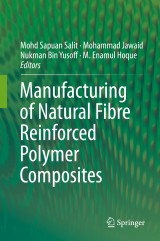Details

Manufacturing of Natural Fibre Reinforced Polymer Composites
|
149,79 € |
|
| Verlag: | Springer |
| Format: | |
| Veröffentl.: | 10.09.2015 |
| ISBN/EAN: | 9783319079448 |
| Sprache: | englisch |
Dieses eBook enthält ein Wasserzeichen.
Beschreibungen
Natural fibre composite is an emerging material that has great potential to be used in engineering application. Oil palm, sugar palm, bagasse, coir, banana stem, hemp, jute, sisal, kenaf, roselle, rice husk, betul nut husk and cocoa pod are among the natural fibres reported to be used as reinforcing materials in polymer composites. Natural fibre composites were used in many industries such as automotive, building, furniture, marine and aerospace industries. The advantages of natural fibre composites include low cost, renewable, abundance, light weight, less abrasive and they are suitable to be used in semi or non-structural engineering components. Research on various aspects of natural fibre composites such as characterization, determination of properties and design have been extensively carried out. However, publications that reported on research of manufacture of natural fibre composites are very limited. Specifically, although manufacturing methods of components from natural fibre composites are similar to those of components from conventional fibre composites such as glass, carbon and Kevlar fibres, modification of equipment used for conventional fibre composites may be required. This book fills the gap of knowledge in the field of natural fibre composites for the research community. Among the methods reported that are being used to produce components from natural fibre composites include hand lay-up, compression moulding, filament winding, injection moulding, resin transfer moulding, pultrusion and vacuum bag moulding. This book is also intended to address some research on secondary processing such as machining and laser welding of natural fibre composites. It is hoped that publication of this book will provide the readers new knowledge and understanding on the manufacture of natural fibre composites.
The Relationship between Manufacturing and Design for Manufacturing in Product Development of Natural Fibre Composites.- Introduction to Manufacturing of Natural Fiber Reinforced Polymer Composites.- Green Composites Manufacturing via Compression Molding and Thermoforming.- Compaction, Permeability and Flow Simulation for Liquid Composite Moulding of Natural Fibre Composites.- Manufacturing and Processing of Kenaf Fiber Reinforced Epoxy Composites via Different Methods.- Critical Concerns on Manufacturing Processes of Natural Fibre Reinforced Polymer Composites.- Challenges in Machining of Natural fiber Composites.- Yarn Flax Fibres for Polymer-Coated Sutures and Hand Lay-up Polymer Composite Laminates.- Effect of Processing Conditions on the Mechanical and Morphological Properties of Composites Reinforced by Natural Fibers.- Manufacturing of Long Puchika Grass Fibre Reinforced Polyester Composites – Assessment under Mechanical and Dielectric Loading.- Pultrusion Process of Natural Fibre Reinforced Polymer Composites.- Bio-nanocomposites from Natural Fiber Derivatives: Manufacturing and Properties.- The Manufacturing of Natural Fiber Reinforced Composites by Resin Transfer Molding Process.- Manufacturing of Chemically Modified Date Palm Leaf Fiber Reinforced.- Manufacturing of Coir Fiber Reinforced Polymer Composites by Hot Compression Technique.- Manufacturing of Natural Fibre Reinforced Polymer Composites by Solvent Casting Method.- Processability of Wood Fiber Filled Thermoplastic Composite Thin-Walled Parts using Injection Moulding.- Filament Winding Process for Kenaf Fibre Reinforced Polymer Composites.
Natural fibers, derived from oil palm, sugar palm, bagasse, coir, banana stem, hemp, jute, sisal, kenaf, roselle, rice husk, betul nut husk, and cocoa pod, have been considered as reinforcing materials in polymer composites. The unique properties of natural fibers including low cost, renewable, abundance, light weight, and less abrasive, suggest that they are suitable as semi-structural or non-structural engineering components. Although research on natural fiber composites such as characterization, determination of properties, and design have been extensively carried out, these information are scattered and not easily accessible to non-specialists. This book addresses such shortcoming and provides detailed accounts of natural fiber composites in terms of their physical and chemical properties, in relation to their applications in the manufacturing and engineering industries. Chapters, written by experts in their respective fields, highlight the hidden values of natural fibers for all those who are interested in this exciting research discipline.
<p>International experts contribute to the state-of-the-art knowledge in natural fiber composite manufacturing</p><p>Highlights the problems and provides solutions to working with natural fiber composite</p><p>Practical approaches to equipment modification for manufacturing natural fiber composite</p>
Diese Produkte könnten Sie auch interessieren:

Agricultural Biodiversity and Biotechnology in Economic Development

von: Joseph Cooper, Leslie Lipper, David Zilberman

213,99 €

Policy Reforms and Agriculture Development in Central Asia

von: Sandjar Djalalov, Suresh Chandra Babu

213,99 €

Regulating Agricultural Biotechnology

von: Richard E. Just, Julian M. Alston, David Zilberman

213,99 €













